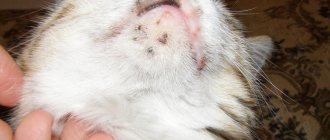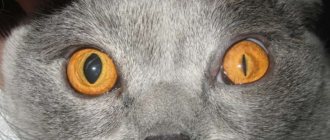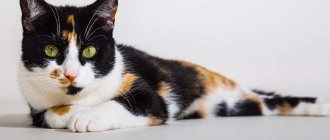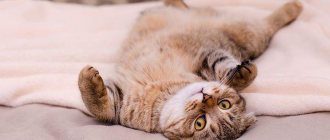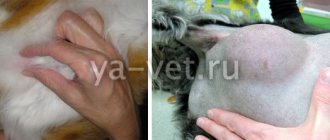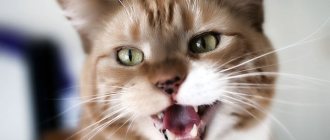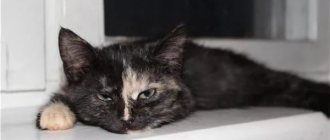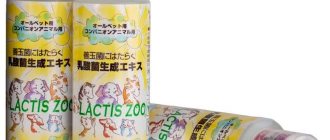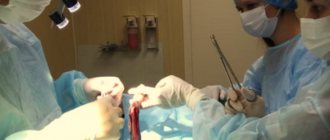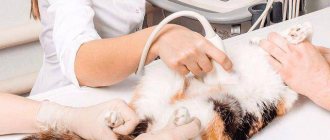Unfortunately, wounds in pets are a fairly common occurrence that many owners have to deal with. Most often, cuts, bruises or scratches heal on their own and do not pose any danger to the animal. But there are also injuries that can greatly worsen the cat’s condition. In order not to endanger the health of your pets, “Murkosha” will tell you the basic rules of treatment and first aid that all owners need to know.
1) What is a wound 2) How to determine that a cat has a wound 3) First aid and wound treatment 4) Further care 5) Possible complications 6) Prevention of wounds in cats
What is a wound
A wound is an injury that results in a violation of the integrity of the skin or mucous membrane. There are several types of wounds in kittens:
1. An incised wound is the result of injury with a sharp object (knife, razor). This type of damage heals quite quickly, since the tissue is almost not destroyed. 2. A puncture wound appears as a result of interaction with a long and sharp object (an awl, a knitting needle). Such damage is characterized by a small wound area on the surface of the body and a relatively large depth. 3. A chopped wound is the result of a strong impact from a sharp object at an angle to the tissue. It causes severe pain and bleeding. 4. A bruised wound appears from a blow to the body with a blunt object. Muscle tissue is crushed, which increases the chance of wound infection. 5. A crushed wound is the same as a bruised one, but with more severe damage and much more extensive. 6. Bite wound - damage received during interaction with other animals. It has its own danger - infection can occur with the microflora of the attacking animal's oral cavity. Therefore, complications often occur with this type of wound (rabies, tetanus, etc.).
Read more about infections in cats: What you need to know about cat infections
7. A poisoned wound is the result of contact with an animal toxic substance (snake bite, household chemicals) on the damaged skin. 8. Gunshot wound.
There are also mixed types of wounds that combine signs of several types at once. Cats can get injured in different ways: in fights with other cats or dogs, while climbing trees, roofs and fences, carelessly jumping from shelf to shelf in an apartment, and so on. Damage can also be caused by falling from a height or getting hit by a car (such wounds are most often crushed or bruised). As you can see, the vast majority of potentially dangerous situations where you can get injured are waiting for cats on the street. Let's talk a little further about how to minimize the risk.
What are the types of ulcers?
The main types of skin ulcerative lesions are shown in the table:
| Variety | Peculiarities |
| Simple | Heals quickly, leaving a scar |
| Bacterial | Characterized by the appearance of pus, does not heal well |
| Edema | Covered with a granulation structure that can be easily destroyed with a finger |
| Decubital (bedsore) | Develops due to impaired blood flow due to prolonged immobility of the animal |
| Gangrenous | Characterized by necrosis of areas of the skin of the abdomen |
| Can be dry or wet | |
| Neurotrophic | Occurs due to nerve damage or malnutrition of central nervous system tissues |
How to tell if a cat has a wound
Newly acquired wounds in pets have certain signs and characteristics that are difficult to ignore or not notice:
- swelling; - purulent discharge; - presence of bleeding; - painful sensations; - torn, peeled skin; - change in gait, limping; - increased anxiety of the animal; - bald spots, hair loss in some places; - reluctance to let the owner near any part of the body.
Read more about the signs of an unhealthy cat: Signs of an unhealthy cat
First aid and wound treatment
If the discovered wound is not treated in time, then various pathogenic bacteria can penetrate into it. Infection of the wound leads to suppuration and subsequent complications. To prevent this from happening, you need to know the rules of first aid. Whether you can treat a wound at home depends on its severity. If these are minor scratches or abrasions, then each person is able to cope with it on their own. Regardless of where the wound is located: on the face, on the tail, on the ears or on the paws, there are uniform rules for caring for such injuries. Initial wound treatment at home is carried out as follows:
1) Wash your hands thoroughly and disinfect them with a special solution before starting to treat the injury. 2) Using scissors, carefully trim the fur around the wound. 3) Clean the wound from contamination. For this, it is best to use chlorhexidine, but iodine and brilliant green should not be used, as they can leave chemical burns on the cat’s body. Chlorhexidine is an effective antibacterial drug and has a mild aftereffect - even after drying it continues to kill bacteria. By rinsing the wound with it, bacteria and dirt are removed, which reduces tissue damage. 4) When treating a wound, use a bandage or clean cloth. You should not use cotton wool, as it may leave particles in the wound that will slow down healing. 5) Decide whether to bandage the kitten's wound. It is best to do without bandaging and leave it to heal in the fresh air. However, if your pet tries to lick or chew the wound, it should be covered (although this will slow down healing).
Volunteers at the Murkosha shelter advise all owners to treat the wound not alone, but together with someone. The fact is that kittens may experience pain and try to escape when touching the wound. Such a reaction is possible even if in ordinary life the pet behaves very quietly and calmly. If the wound is large, deep, open, or there is heavy bleeding, then the owners should contact a veterinary clinic for professional help as soon as possible. Almost all deep wounds are closed surgically. After the operation, the specialist prescribes outpatient treatment for the animal using external agents that accelerate wound healing. But before taking your pet there, the wound also needs to be treated.
Read more about how to properly interact with a veterinarian: Five rules for effective interaction with a veterinarian
A little theory
The wound in this case is a violation of the integrity of the skin layer, affecting the underlying tissue . It can be superficial (essentially a serious scratch) or deep, affecting even the muscle layer and large vessels. In pets, such pathologies are most often the result of traumatic exposure. They occur during fights, attacks by other animals, after collisions with cyclists or cars, and also include surgical injuries that have to be inflicted on the animal during surgery. In short, there are many reasons. But in this case, it is much more important to us what happens to the wound in the future.
Its healing can occur in two types , first described by the luminary of Russian medicine, N.I. Pirogov. He distinguished between healing by primary and secondary intention. With primary intention, wounds heal only after surgery: their edges are smooth, regenerative processes start immediately. Considering that during any operation the rules of asepsis and antiseptics are strictly observed, and therefore the effect of pathogenic and conditionally pathogenic microflora is completely excluded. This happens in several stages:
- Granulation. To protect itself from the penetration of microflora and debris into the wound cavity, the body begins to “darn” the wound with granulation. Fibroblasts and endothelial cells participate in the process, and new blood vessels grow from the latter.
- Increasing the epidermal layer. Epithelial cells along the edges of the wound channel gradually begin to “slide” onto the upper surface of the granulation, forming a new layer of skin epidermis.
- Myofibroblasts also play an important role in the healing process. It is from these cells that muscle fibers subsequently develop. They play the role of a kind of “ties”, literally tightening the edges of the former wound channel.
In principle, wound healing by secondary intention proceeds similarly, but in this case pyogenic microflora interferes with the process: complete granulation of the wound canal will not occur until all dead tissue and microbes are removed from the wound along with pus and other secretions. And it is with this process that difficulties may arise...
Further care
After self-treatment of the wound or a visit to the veterinarian, the healing of the kitten’s wound depends solely on proper care for it. “Murkosha” advises all owners to be patient, as this process takes up to two weeks. To speed up your pet's recovery, follow these tips:
- Do not allow the cat to lick wounds. He will instinctively want to do this, but this will not heal them. To prevent this behavior, veterinarians advise using a special collar that will prevent the cat from scratching and licking the wound. — If your pet has dressings, they must be changed regularly when they become dirty and always kept dry. If you cannot change the bandages yourself, then ask friends for help or go to the clinic for bandaging. — The cat must take all prescribed medications on time. The treatment plan will be drawn up in advance by the veterinarian, and all you have to do is strictly follow it. If this is not done, the bacteria will become resistant to the drug and the treatment will be in vain. — Not only the use of medications, but also a balanced diet can speed up your pet’s recovery. The cat should be fed more often than usual - about 5 times a day. The cat's diet must include protein, as it helps healing. In addition, food should be rich in vitamins. All these requirements are met by professional super-premium and holistic-class food. — Report any deterioration in your pet’s condition to your doctor immediately.
Diagnostic measures
Laboratory diagnostics will help establish the correct diagnosis and monitor treatment.
To determine the etiology of an ulcer on a cat’s stomach, the veterinarian conducts a visual examination, finds out what the animal’s diet is, and its history of concomitant diseases. Depending on the preliminary diagnosis, diagnostic methods are prescribed, such as:
- blood test for hormones;
- scraping of scales to identify the pathogen;
- biochemical blood test;
- smear of exudate from an ulcer;
- radiography for injuries.
Possible complications
As we have already found out, if you do not treat your pet in a timely manner, pathogenic bacteria can penetrate into the wound and suppuration will begin to develop in it. If the wound is closed, then pus accumulates inside and an abscess appears. Such replenishment cannot be cured at home with the help of an antiseptic and bandages, so the treatment process is best entrusted to an experienced veterinarian. He will be able to assess the extent of the inflammation and choose the appropriate treatment strategy for your cat.
Complications can also arise if the wound is not completely treated. This can happen if the owners, for example, stop giving the cat medications without completing the course of treatment to the end. At first, it will seem that the pet is absolutely healthy and has finally returned to normal life. But in fact, inflammatory processes will still take place inside his body, which will slowly spread throughout the body. This will affect the general physical condition of the pet, as well as all its internal organs. The immune system will be weak, which means the cat will be highly susceptible to all kinds of viruses and diseases. Thus, if the wound is not completely treated in a timely manner, this will lead to the emergence of new, more dangerous diseases.
How to treat?
Surgical intervention
Surgery is prescribed if it is necessary to open an abscess. An incision is made into the formation and the pus is squeezed out. A suture is applied to stab wounds. To prevent the animal from licking its belly, it is recommended to wear a special bandage. To speed up the regeneration process, you can lubricate the seam with Yoddicerin.
Drug therapy
All medications are prescribed by a doctor. Sores should be treated with the drugs shown in the table:
| Pharmgroup | Name |
| Antihistamines | "Clemastine" |
| "Chlorpheniramine" | |
| Against ticks | "Stronghold" |
| "Demos" | |
| "Neotsidol" | |
| Sulfuric ointment | |
| Hormonal | "Trilostane" |
| Antibiotics | "Levomekol" |
| "Miramistin" | |
| Against deprivation | "Fungin" |
| "Clotrimazole" | |
| "Sanoderm" | |
| Ointment "Yam" |
Prevention of wounds in cats
Statistics show that in 8/10 cases cats are injured if they walk outside unattended. Therefore, the best and most effective way to prevent wounds in cats is to keep them exclusively at home or let them out only in a protected limited space (for example, in the local area of a private house) on a harness under the supervision of their owners. There are too many dangers on the street that threaten a cat: dogs, cars, knackers, and, in the end, other cats. If a pet purr goes out for a walk, then there is a very high probability that sooner or later she will encounter one of these dangers. In this case, there is a risk that the cat will die immediately or receive such a wound that it will run away, get lost and not be able to return home.
Read more about the dangers of self-walking: Self-walking - when freedom means death
At home, the main danger comes from the windows - if they are not protected by special “anti-cat” nets. When ventilated, the cat can easily fall out of the window. Don't rely on mosquito nets - if desired, the cat will tear them apart in no time. If the cat stays exclusively at home, and the windows are protected, then the risk for her to get injured will be minimal (and even in this case, we are more likely to talk about minor scratches or abrasions). And yet, just in case (especially if you have more than one pet), regularly check if your cat has any injuries, abrasions or wounds. It is most convenient to do this while you are stroking it, since it is not always possible to notice changes during a visual inspection.
“Murkosha” hopes that now all owners know how to help their pet in case of danger. It is very easy to provide first aid when a kitten is injured, so do not put it off until later and try to treat the wound as quickly as possible. Well, it’s best to avoid this altogether: eliminate self-walking and protect the windows with special nets.
Question answer
What if a cat scratches a wound?
First you need to find out the reason why she does this. If the problem is an incorrectly selected wound healing agent (excessively irritating effect or, for example, an allergy), then it should definitely be replaced with another one. Perhaps the reason lies elsewhere: for example, wounds on the head from scratching due to a parasitic infection (subcutaneous mite). In this case, first treatment is carried out for cutaneous and intradermal parasites, the ears are checked for the presence of otitis media or mites, the underlying disease is treated, and then only something is prescribed to heal the wounds. Kidney diseases and some endocrine diseases.
What to do if your cat has a wound on the neck?
Treatment and treatment will depend on the depth of the wound. A common injury of small size and with a deep scratch can be treated at home. Due to the fact that the skin on the neck is very mobile with the possibility of folds, abscesses often form in the neck area, which will not heal without drainage - this is the task of a specialist. With deep penetrating wounds on the neck, you should immediately go to the veterinarian. Emphasis should be placed on the fact that very often wounds on the neck are formed from scratching against the background of scabies (subcutaneous sarcoptic mite). Without treating the underlying disease, scratches and wounds cannot be cured; they will constantly itch and become injured. As soon as the tick is removed, you can begin to directly treat the wounds.
Does a cat need antibiotics for wounds?
Yes, in order to avoid the development of sepsis, in some individual cases with extensive purulent processes, broad-spectrum antibiotics (injection or orally) must be prescribed.
What if your cat has an ear injury?
For superficial injuries of the ears, treatment is carried out as usual scratches and abrasions. If the ear is torn (torn edge or hole in the middle), stitches may be needed. Sutures in cats' ears are applied with small, thin needles; there are practically no traces of them.
What if a cat's wound does not heal for a long time?
If no positive dynamics in healing are observed for more than 3-4 weeks, it is assumed that somewhere an error was made in therapy (incorrect treatment, incorrectly selected treatment agent, etc.). It should be remembered that such wounds can increase in size, because... wound discharge literally softens and dissolves healthy tissue around it. It is necessary to conduct a qualified inspection of the wound, change the treatment regimen and medications. A specialist must deal with everything. Sometimes in such cases, cats are prescribed intramuscular injections of pyrogenal (1.5 mcg/kg) every two days until healing (a drug that activates the healing of wounds by stimulating the division of “correct” skin cells, softening the scarring process).
What to do if your cat has a wound on its paw?
They require increased attention at the folds or in the area of the pads, because the places are constantly irritated by external influence and bending, and it is almost impossible to apply a bandage to them. You should be prepared for the fact that in such places the healing processes are somewhat slower. The general treatment algorithm is the same as for all other wounds.
Purulent wound in a cat
When bacteria enter the wound, a pyogenic process develops. It is best to go to a veterinary hospital, because... Such injuries require increased attention and qualified treatment. Broad-spectrum antibiotics are often prescribed. If it is not possible to take it to a veterinarian, you should rinse the wound generously with hydrogen peroxide and apply antimicrobial ointment/or any antiseptic powder under the bandage. The most commonly prescribed antibiotics are ciprofloxacin tablets or ceftriaxone injections.
What antibiotics are needed for cats with purulent wounds?
If there are all signs of purulent inflammation, then antimicrobial agents of the following groups are usually prescribed: penicillins, cephalosporins and sulfonamides. Application, both local and systemic (in the form of injections). Particular attention is paid to wound infections, which are accompanied by an increase in general temperature. The name of the antibiotic, duration of the course and methods of use are determined only by a specialist.
A cat has mammary cancer: the wound has opened - what to do?
Nothing much can be done anymore. The purpose of treating oncological ulcers is to minimize bacterial contamination and the development of an additional purulent process. Those. it is important to simply alleviate the animal’s condition and prevent pyogenic bacteria from entering the wound. For treatment, non-irritating antiseptics are used - chlorhexidine solution, furacillin, light pink manganese solution. A putrid specific smell can only be prevented by frequent changes of gauze wound dressings. For small areas, the use of Oflocain, Levomekol or Actovegin ointments is allowed.
What to do if your cat licks a wound?
It is not advisable to let your pet lick the wound. The rough surface of the tongue will injure the damaged surface and “grind” the edges of the wound, slowing down the healing process. Some healing solutions, ointments or creams can cause food poisoning if your cat licks any of it, another reason to limit your cat's access to the injury. If it is not possible to apply a bandage, you can put a special conical collar on the cat so that it does not reach the site of injury.
Weeping wound in a cat: what to do?
Weeping wounds are an injured area of skin that does not heal for a long time (it does not even heal). Ichor or purulent exudate constantly oozes from this place. Often accompanied by an unpleasant odor. With such a problem, you definitely need to go to the veterinary clinic. What is needed is proper cleaning of the surface of such a wound, possibly removal of damaged and dead skin areas, proper antiseptic treatment and selection of the correct wound-healing components that will dry out the weeping surface. These wounds are usually covered with bandages. Powdery antiseptic powders are most often used. Synthomycin ointment, applied to the purulent surface under a bandage after preliminary cleansing of the wound, has proven itself to be effective in the treatment of weeping wounds in cats.
